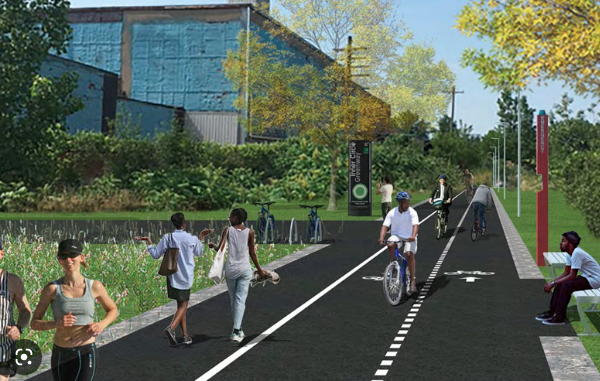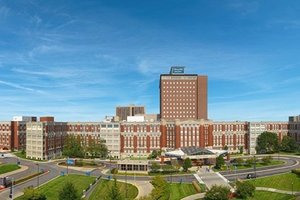Joe Louis Greenway Project Aims to Transform Abandoned Rail Corridor into 27.5-Mile Recreational Pathway

The Joe Louis Greenway is a 27.5-mile pathway that will connect 23 neighborhoods and the cities of Detroit, Hamtramck, Highland Park, and Dearborn to each other and to the Detroit riverfront, Dequindre Cut, Belle Isle, pedestrian/cyclist crossings at the Ambassador and Gordie Howe International bridges, and other trails. Upon completion, more than 40,000 residents will be able to walk to the greenway within 10 minutes. The project is based on a Framework Plan funded by the Ralph C. Wilson, Jr. Foundation and shaped by voices from the community. The General Services Department team led 14 community meetings and attended more than 40 other events and meetings to gather feedback from residents to create the plan. The project is being recognized for its focus on inclusion, and for bringing a wide range of voices to the table while fostering citizen advocacy and activism. In October, The American Planning Association awarded the 2022 Advancing Diversity and Social Change in Honor of Paul Davidoff Award to the project. The greenway has received significant state and federal funding. And earlier this month, the city of Detroit, Detroit Riverfront Conservancy, and Joe Louis Greenway Partnership announced the Unified Greenway Partnership, an alliance that will raise funds to complete the Detroit Riverfront from Belle Isle to the Ambassador Bridge, build the Joe Louis Greenway around the city, and endow both projects for long-term management. SBN Detroit spoke to Brad Dick, COO for the City of Detroit, about inclusion, the use of space for social justice, and the greenway’s potential impact on area businesses and new business development. Q: There is a significant amount of funding from different entities coming in for the greenway. What are your thoughts on the ‘investment in urban spaces’ and the implications this has on small businesses in the area, as well as the opportunities this represents for new business development? A: The Joe Louis Greenway (JLG) is a historic investment across multiple cities and neighborhoods, including Detroit, Highland Park, Hamtramck, and Dearborn. The greenway will transform a blighted, abandoned rail corridor into a beautiful park running through Detroiters’ backyards. To date, the project has removed more than 68,000 cubic yards of debris (which could fill 22 Olympic-sized swimming pools) and nearly 23,000 old, illegally dumped tires from the area, and is investing in permanent infrastructure and beautification that enhances the quality of life and provides equitable access to public resources. Investment in urban spaces brings communities together and provides economic opportunities for local entrepreneurs and businesses to grow and expand, creating jobs, and economic growth, as well as wealth-building opportunities for our residents along the greenway itself and in adjacent communities. Our goal is to make this greenway a destination, which will attract people from all over the region, creating a strong market for existing and new small businesses. The greenway will also provide safe routes, and comfortable connections for both employees and business owners to get to work. Q: How has this project established itself as a model for neighborhood stabilization and for addressing community-based issues as it pertains to social justice? A: Residents have been at the core of the planning process for the Joe Louis Greenway, and hundreds of Detroiters attended community meetings held as part of the Joe Louis Greenway Framework Plan. The Joe Louis Greenway Citizen Advisory Council helped guide the planning process and continues to advocate for the Greenway. The group of dedicated individuals that guided the Framework Plan represented all seven of Detroit’s Council Districts, as well as residents of Highland Park, Dearborn, and Hamtramck, which also touch the Greenway. Joe Louis worked tirelessly to advocate for the rights of Black Americans and to promote social justice in the United States. The Greenway is more than a tribute to his legacy. It celebrates Joe Louis as a role model and as someone whose values can guide this project and the Detroiters it brings together. Q: What are the equitable economic development benefits of this project? A: The JLG is about access – including access to opportunity. Intentional planning, outreach, and action will create economic opportunity for residents in every neighborhood that the Joe Louis Greenway touches. The economic development benefits will include blight reduction and beautification, housing stabilization, preservation of affordable housing, job training, and career opportunities, existing and new small business support, and light industrial development opportunities. The Neighborhood Planning Study, led by Planning and Development Department, will continue the dialogue with the community and focus on opportunities for community and economic development along the Greenway. Q: How will the Neighborhood Planning Study support social justice as well as economic and business/job opportunities? A: As Mayor Mike Duggan has said, the impact of this greenway will extend far beyond the boundaries of the path itself, creating opportunities for Detroiters to thrive. When complete, the greenway will generate jobs and affordable housing opportunities, and ease mobility barriers that have challenged Detroiters for decades. It also will help Detroiters build generational wealth for homeowners by increasing their property values through the beautification and economic investment that the greenway will bring to their neighborhood. Throughout the planning process, residents voiced a need to heal long-standing urban trauma, particularly concerning urban renewal that ultimately displaced Black residents who called those neighborhoods home and whose businesses were torn down. By acknowledging that past trauma, promoting dialogue, and providing new opportunities for healing, the greenway can be a place where Detroiters advance a better understanding of racial justice. Q: How is the greenway helping to build a more sustainable Detroit? A: The design of the greenway incorporates stormwater management to reduce flooding impacts, native meadow plantings to provide bird habitat, and trees throughout to provide shade and help with air quality. Sustainability, however, goes much further than just the environment. This project will impact many facets of sustainability, including public health, economic development, neighborhood stabilization, park access, and connectivity. The Framework Plan ensures that the Joe Louis Greenway will transform the infrastructure that previously divided neighborhoods into one that unites community and reconnects natural systems, catalyzes economic redevelopment, and supports a resilient social network. The
Sustainability in Health Care: A Look at Henry Ford Health’s Green Efforts

Health care leaders have the uniquechallenge of improving the health and well-being of the individuals, neighborhoods, and communities they serve while simultaneously working to minimize negative and health-depreciating impacts on the environment. We spoke to Chip Amoe, who became Henry Ford Health’s first director of sustainability in 2018, about the challenges and successes he faces as he leads HFH to become more ‘green.’ Founded in 1915 by Henry Ford himself, Henry Ford Health is a not-for-profit, academic, and integrated health system comprising five acute-care hospitals, three behavioral health facilities, a health plan, and 250-plus care sites including medical centers, same-day, and urgent care clinics, pharmacies, eye care facilities, and other health care operations. The health system has more than 33,000 employees and nearly 6,000 physicians and researchers. Amoe took on the role with a conviction that HFH can work to lead by example and help influence the sustainability policies and actions of government officials and other businesses in the state and region. His original initiatives focused on reducing plastic and Styrofoam waste, exploring ways to reduce greenhouse gas emissions through energy reduction, and standardizing efforts across the system. Toward the goal of reducing greenhouse gas emissions, in December 2021 Henry Ford announced they will begin purchasing wind and solar energy through DTE’s voluntary renewable energy program, MIGreenPower. Amoe says, Our overall goal here is to reduce scope 1 & 2 emissions by 50% by 2030. To do that we need to reduce emissions from purchased energy. We plan to start purchasing this renewable energy in 2023, the earliest it will be available, and ramp it up over time. To that end, initially, 10% (approximately 19,100 mega-watt hours) of Henry Ford’s total electricity purchased from DTE will come from Michigan-made renewable energy, increasing incrementally to 100% by 2029. Henry Ford’s clean energy commitment with DTE will begin in late 2023. The organization states its initial purchase will reduce greenhouse gas emissions by roughly 13,536 metric tons, the equivalent of removing 2,944 passenger vehicles from the road each year. In terms of setting longer-term goals, Amoe said, “There are several national organizations that have developed green healthcare standards for healthcare systems. Taking those into consideration, we also felt it was important to turnto our internal priorities that align directly with our mission of improving the health of the communities we serve and that link health and sustainability.” The following five goals are derived from that exercise: Reduce emissions from operations Eliminate chemicals of concern, i.e. furnishings, cleaning chemicals, certain medical devices Reduce waste to landfills, such as bottled water, food waste, packaging, and utilizing reprocessed equipment Increase the purchase of local and sustainable food Increase the investment in green and healthy infrastructure, such as green spaces, stormwater management, advocacy around public transportation and employee commuting, and more When asked what pitfalls Henry Ford Health faces in implementing green efforts, Amoe cited two large challenges. “Data collecting is a huge challenge,” he said. “When I came on board I assumed the information was being collected and housed so that we could track it. But I quickly learned that wasn’t the case.We’re a large, complex system and there are multiple data sources maintained by multiple departments so you inevitably come to understand thereare gaps in the information. And you can’t move what you can’t measure. We are working to streamline our data collection efforts and it’s a long process.” The second challenge is the state of the U.S. recycling market. Just as I started my role in 2018, China announced that it would no longer be accepting recycled material from the U.S. This has been a big hit to the U.S. recycling market and made it much more challenging. Combine that with low landfill tipping fees in the state and the lack of recycling infrastructure in the region and that means recycling is often more expensive than throwing things away. Despite the challenges, Amoe and the Henry Ford team have implemented several initiatives in the past four years, including: Reducing the use of more potent anesthetic gasses from operating rooms to reduce emissions Eliminating Styrofoam from all their retail locations Upgrading exterior lighting to reduce energy waste Hosting their first zero-waste event They have also partnered with Friends of the Rouge to create raingardens at their new Plymouth medical center and south campus to divert stormwater and offer green space. When asked what the health care industry could improve on to forward sustainability efforts, Amoe said “it’s important to come together as an industry around common standards, and work with outside vendors as an industry to request and gather data in a common format so that vendors know how they can help us meet our shared goals of improving the health of our communities Additionally, the Michigan Health and Hospital Association Green Health Care Committee – which Amoe chairs – recently launched an MHA-approved Health Care Sustainability Road Map to give health systems a place to start when it comes to sustainability. “We are working to develop common standards and to provide resources to hospitals in Michigan and beyond.” In the end, Amoe says, “We hope to demonstrate to our staff, patients, vendors, and surrounding businesses the connection between health and sustainability, and further, to facilitate positive choices that impact the overall health of our community.” Be sure to subscribe to our newsletter for regular updates on sustainable business practices in and around Detroit.


